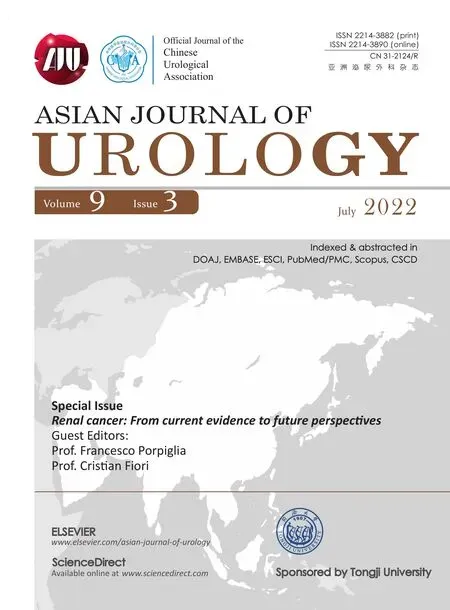Renal cancer:From current evidence to future perspectives
It has been a great honor to have the opportunity to serve as guest editors for this issue of the Asian Journal of Urology(AJU)on renal cancer.
Renal cell carcinoma(RCC)represents about 3% of all adult malignancies and 95%of all renal masses and it is still one of the most lethal urological cancers[1].In the last decades,diagnosis and management of RCC have rapidly changed.As incidental diagnosis of small cancers has become more frequent due to the wider use of imaging techniques,active surveillance and nephron-sparing surgical techniques mainly performed with minimally invasive approaches have become popular.Despite diagnostic and therapeutic advances,locally advanced disease and distant metastases are still found in a non-negligible proportion of patients.In these patients,surgical debulking,genomic studies,and systemic treatment with targeted biological drugs may be the key for survival’s improvement.
In this special issue of AJU,we tried to deal with all these aspects.
Rebez and Mir reviewed the current perspectives on active surveillance,a recently“re-discovered”treatment modality for small renal masses[2-4],underlying that the key for the success of this approach is represented by the inclusion of the evaluation of patient-specific prognosis related to the competing health risks and their quality of life status.
Piana and the group of Fundacio Puigvert(Barcellona,Spain)focused on the management of small renal masses in transplanted kidney.This is an infrequent condition(especially when considering de novo renal tumors in allograft patients)that can be effectively managed by using all the armamentarium in the hand of modern urologists.
One of the points of“never-ending”debate in the scenario of renal cancer is the lymph node dissection(LND)during radical nephrectomy.Whilst some authors argued that LND has no role in determining patients’survival,there is still a significant proportion of clinicians suggesting a survival benefit for LND,especially in highrisk patients[5].In their review,Marchioni and the European Association of Urology Young Academic Urologists(YAU)Renal Cancer Group reviewed the potential benefit of LND during radical nephrectomy for kidney cancer,concluding that no robust evidence of any survival advantage deriving from LND is currently available in literature and the role of LND should then be limited to staging purposes.
Notwithstanding the efforts of surgeons in performing a successful procedure,local recurrence after partial nephrectomy(PN)is still an issue[6].Carbonara et al.summarized current strategies to manage both positive surgical margins and local recurrence after PN.Active surveillance,thermal ablation,salvage PN,and radical nephrectomy-especially when performed with minimally invasive approaches-are basic pieces of the complex mosaic that could be offered to our patients.
Today,even if we face a large proportion of small renal masses and T2 tumors,we should not forget locally advanced non-metastatic disease.Despite an increasing interest in systemic treatments in recent years[7,8],for locally advanced non-metastatic RCC,nephrectomy remains a key therapeutic step to control the disease,aiming to achieve cure.
Campi et al.from the University of Florence,Italy,reported the techniques and outcomes of surgery for locally advanced RCC,focusing on inferior vena cava thrombectomy.
If surgery is the milestone of the treatment of local and locally advanced disease,systemic therapy is the mainstay of metastatic renal cancer and we must recall that metastatic renal cancer represents about one third of newly diagnosed RCC.In this scenario,different drugs are currently used such as anti-programmed death-1 antibody,vascular endothelial growth factor receptor,tyrosine kinase inhibitor,and multi-target tyrosine kinase inhibitor[9].The development of new biomarkers able to define the response to the available treatments would then be fundamental.Giunta et al.from Candiolo Cancer Institute,Turin,Italy assessed the role of genome expression profile as an instrument to define the response to specific treatments,aiming to guide the clinicians in the best therapeutic choice.
As we are strongly convinced that continuous innovation is essential for reaching ever more successes in the fight against renal cancer,we dedicated several papers to themost“futuristic”aspects of the research in the surgical treatment of RCC:artificial intelligence(AI)and new imaging modalities.
Even if the role of AI in urologic practice is still limited,there is no doubt about the potential applications of this technology in the next years in urology,especially in the oncological field(i.e.prediction of biopsy results,prediction of recurrence-free probability)[10].Moreover,AI already plays an important role in some fields closely related to urology such as pathology(especially in prostate cancer)and imaging(prostate cancer and kidney cancer)[11-13].Kowalewski et al.on behalf of the YAU-Urotechnology-Group focused on current applications of AI in the field of RCC,investigating different aspects,from imaging to histology.
Among new imaging modalities,three-dimensional virtual models(3DVMs)have gained popularity.These models are currently used in the preoperative planning,for intraoperative assistance and are the key for augmented reality guided procedures,especially for prostate and kidney cancers.In the last years,our group intensively explored the applications of 3DVMs suggesting the appealing role of this tool[14-16].To add a further contribution in this field,in this issue we gave to the reader a snapshot of image guided surgery and we reported our experience with minimally invasive PN guided by 3DVMs compared with the standard laparoscopic and robotic approach,demonstrating that the 3DVMs group showed better postoperative outcomes in terms of renal function and complications.On the same topic,Puliatti et al.reviewed newer technologies from fluorescence to confocal endomicroscopy.
Finally,we would like to thank all the authors for these excellent papers and the editorial team of AJU for the continuous support.We hope that this issue may serve both as“food for thought”and as a guide for the“everyday”clinical practice of the readers of AJU.
Author contributions
Manuscript writing:Cristian Fiori.
Study concept and design:Cristian Fiori.
Supervision:Francesco Porpiglia.
Conflicts of interest
The authors declare no conflict of interest.
Cristian Fiori*Francesco Porpiglia Department of Oncology-University of Turin,San Luigi Hospital,Orbassano,Turin,Italy
*Corresponding author.
E-mail address:cristian.fiori@unito.it(C.Fiori)
18 May 2022
 Asian Journal of Urology2022年3期
Asian Journal of Urology2022年3期
- Asian Journal of Urology的其它文章
- Burned-out testicular seminoma with retroperitoneal metastasis and contralateral sertoli cell-only syndrome
- Endoscopic management of adolescent closed Cowper’s gland syringocele with holmium:YAG laser
- Transcutaneous dorsal penile nerve stimulation for the treatment of premature ejaculation:A novel technique
- Bilateral calcified Macroplastique? after 12 years
- Culture-positive urinary tract infection following micturating cystourethrogram in children
- A phase II study of neoadjuvant chemotherapy followed by organ preservation in patients with muscle-invasive bladder cancer
